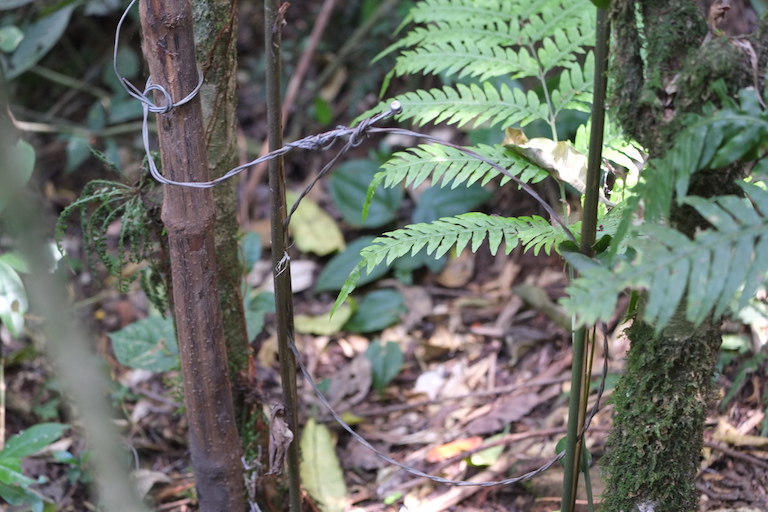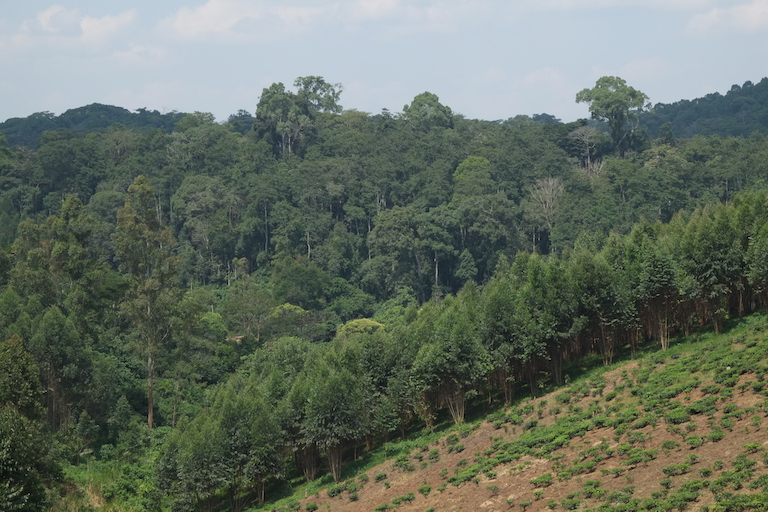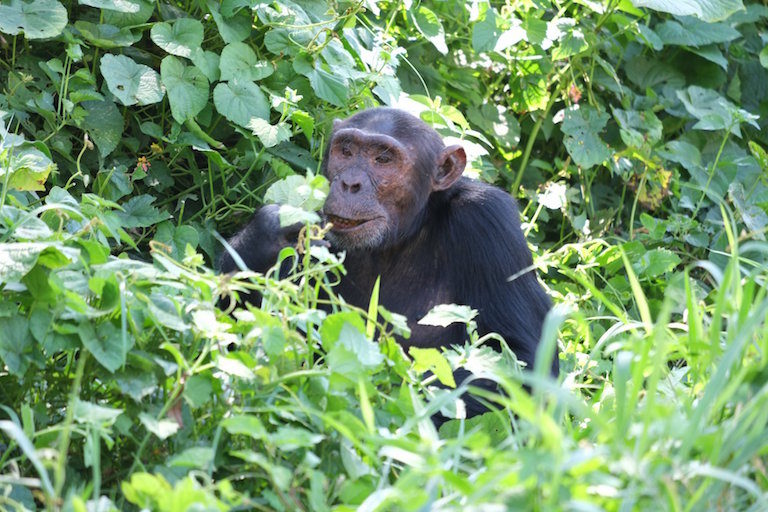- Frequent patrols in Uganda’s Kibale National Park are credited with helping reduce the risk of the resident chimpanzees falling victim to the snare traps set by poachers targeting bushmeat.
- While chimpanzees aren’t typically eaten here as bushmeat, the indiscriminate nature of the traps means they still risk being killed or severely maimed.
- A booming human population on the periphery of the park is putting pressure on the wildlife inside, with hunters not just targeting small game for bushmeat, but also forest elephants for ivory.
- The frequency at which chimps get snared here has gone down from one incident every nine months, to once in 15 months, with rangers finding and removing about 45 snare traps a month.
KANYAWARA, Uganda — As they hack their way with pangas through the dense and prickly undergrowth, a palpable sense of tension grips the camo-clad patrol party navigating the rainforest of Kibale National Park. An hour and a half into their hike, they hastily change course and flee to higher ground, keeping upwind of the forest elephant (Loxodonta cyclotis) bull glimpsed by the team leader. More than once, they come to a halt as patrol members sink knee-deep into black soil that has been liquified by unseasonal summer downpours.
These hazards are just an ordinary part of the job for members of the Kibale Snare Removal Program (KSRP) team. Despite the setbacks, they steadily traverse the forest. By mid-afternoon, after eight hours on foot, the team encounters what it has been searching for. Tucked in the vegetation just within the park’s boundary lie two wire snares: crude but lethally effective devices used to catch bushmeat for consumption by people from neighboring communities. After carefully recording the traps’ GPS coordinates into a mobile device, the team hacks apart the wooden posts anchoring the snares and seizes the wires to be melted down.
The patrol — a joint endeavor between rangers from the Uganda Wildlife Authority (UWA) and staff from the KSRP, an arm of the Kibale Chimpanzee Project (KCP) — vividly illustrates one of the key challenges facing conservation in Kibale: protecting chimpanzees (Pan troglodytes) from falling prey to snares set for other animals.
A 2000 study estimated that 15,000 snares are set within the park at any given time, leading to a 3.7% risk of a chimp being snared every year. Beyond Kibale, snares have caused permanent physical deformities among a third of Uganda’s entire chimpanzee population.

Accidental victims
The roughly 1,200 eastern chimpanzees (P. t. schweinfurthii) sheltered within Kibale comprise several of the longest and most carefully studied populations on the African continent. Since primatologist Richard Wrangham, the KCP’s founder and co-director, began researching the park’s chimps in 1987, Kibale has yielded some of the most important discoveries about the species’ society and behavior.
East Africa’s last significant tract of mid-altitude tropical rainforest, Kibale boasts 12 other primate species and the highest primate density of any protected area in Africa. But despite this bounty of biodiversity, habituated chimpanzee communities are the park’s main draw for international tourists.
Together, chimpanzee research and tourism generate key employment opportunities for residents, many of whom serve as field assistants for visiting primatologists, UWA chimp-tracking guides for tourists, or staff at safari lodges. In addition, 20% of park entry fees are shared with local governments for community infrastructure.
Despite these benefits, the park often poses a mixed blessing for nearby communities. In a 2012 survey of households outside Kibale, 83% of respondents reported facing problems from the park, while only a third perceived benefits. The most common problem cited was human-wildlife conflict, particularly in the form of crop-raiding by elephants. Grievances rarely stem from or are directed toward the park’s chimpanzees.

Even before Kibale was established, the area’s residents largely coexisted peacefully with chimpanzees. In contrast to many chimp populations throughout West and Central Africa, which have declined precipitously due to the spiraling bushmeat trade, traditional taboos against consuming primates are thought to have safeguarded those in Uganda against deliberate slaughter.
“I think [for] people [the chimpanzee] is something which is near to people, it looks like a human being,” Patrick Abimanyire, one of the KSRP’s patrol staff, said in an interview at KCP headquarters in Kibale in July 2019. “They have that mentality that when you are eating a chimpanzee, it as if you are eating a friend or yourself. So since it is very close to people, that’s why they have that mentality and they are not hunting them.”
Jessica Hartel, a biology lecturer at the University of Georgia who also serves as the KCP’s director of conservation, said farmers in Kibale do not perceive chimps as problem animals to the same extent they do other foraging animals like olive baboons (Papio anubis) or elephants. “Chimpanzees are incredibly intelligent,” she says. When they do engage in crop-foraging, they do so very cryptically and often under cover of night.
“They can just pick a few maize stalks and then leave, so people sometimes may not know which wildlife to blame,” Hartel says. On occasions when chimps are sighted in a farm patch, KCP’s field assistants alert the patch’s owner, and encourage non-aggressive methods like yelling and hand-clapping to chase the animals back into the park, thereby minimizing the chance of hostilities.
Yet while these factors have encouraged chimp conservation in Kibale, they do not protect apes from suffering due to the hunting of other species inside the park.

Growing pressure
Since the 1950s, beginning with mass migration from land-scarce southwestern Uganda and subsequently compounded by natural growth, human populations outside Kibale grew by almost 400%. At the national level, Uganda’s population continues to grow by around 3.5% annually. Half of the country’s population of 45 million is under the age of 15, and the total population is predicted to reach 100 million by 2050.
Within the matrix of massive tea estates and small-scale family farms encircling Kibale’s intact rainforest, only 22% of adults are formally employed, with three-quarters working as farm laborers or tea plantation workers. The park beckons to impoverished residents as a natural supermarket boasting abundant, and free, protein. Hence, the rampant setting of snares. Although the intended targets are small game such as duikers, bushbucks (Tragelaphus scriptus), and bushpigs (Potamochoerus larvatus), the traps do not distinguish between these species and those that Ugandans have traditionally refrained from consuming. “Chimpanzees here are not eaten,” says Paul Mugisha, the head of the KSRP’s patrols. “Snares are always set for ungulates, [and] chimpanzees are always accidental victims.”
Many of Kibale’s chimps bear telltale injuries — from missing or paralyzed digits to stumped hands or feet — years or decades after encountering the snares. The problem is too huge for UWA to mitigate alone, prompting the joint efforts with KCP to address both poaching in Kibale and the grievances that spur it.

Challenges and successes
According to Mugisha, the KSRP’s 24 monthly patrols in Kanyawara, Kibale’s northwestern sector, dismantle on average 1.5 snares per day, totaling 45 per month. Additionally, in the process, patrol members often find pits excavated to trap buffalos or antelope for their meat or elephants for their ivory. When they find these pits, Mugisha says, teams will remove the branches and vegetation used to conceal the traps, but leave the open pits behind. “We just inform the Uganda Wildlife Authority for more manpower and equipment to come and fill the pit.”
Besides the arduous terrain and possibility of run-ins with elephants in the thick vegetation, the patrol staff brave the risk of encounters with poachers armed with spears and hunting dogs. “We know to [escort poachers to an UWA outpost] and how to avoid injuries,” Mugisha says. “You can’t confront a big number of poachers, [because] they will overpower you and probably kill you. So, in such incidents, we avoid them but communicate to UWA.”
Consequently, two UWA rangers usually escort patrols by the KSRP and its counterpart organizations, the Ngogo Chimpanzee Project and Sebitoli Chimpanzee Project, which respectively patrol against snares in Kibale’s central and northern zones. KSRP staff say the combined patrols by all of these chimpanzee organizations help UWA to cover most of the park each month.

Despite the difficulties and hazards, the patrol campaign has yielded gains. “When we look at data before the snare removal program started, our chimp community averaged one snaring event every nine months,” Hartel says. “Then when we look at the average after the establishment of the program, that interval has increased to once every 15 months.” In July 2019, a male lost the tips of his ring and index fingers on his left hand, but has since recovered well and is using his hand normally. Remarkably though, until that point, a record two years had passed without any known snaring incidents among the Kanyawara chimp community.
More recently, in January 2020, as part of its new Chimpanzee Health, Intervention, and Monitoring Program (CHIMP), the KCP hired an on-site chimpanzee and wildlife veterinarian, Nelson Bukamba, in collaboration with UWA and the Jane Goodall Institute of Uganda. In his first month on the job, Bukamba was able to remove a snare from the left hand of a young female Kanyawara chimp, avoiding any lasting injuries.
Addressing cause as well as effect
The patrol staff, Hartel, and KCP field director Emily Otali all recognize the limitations of simply removing snares, rather than tackling the problem’s root causes. In addition to filling a need for protein, snaring also stems from resentment of the depredations brought about by baboons, elephants, and even to a lesser extent chimpanzees, which were first detected through camera traps in 2014 raiding maize fields outside Kibale. “Unless they change their attitude, people will not stop setting snares,” Mugisha says. “And removing [snares] is not a lasting solution.”
This reality was illustrated horrifically in July 2019, when a female chimpanzee from Kibale’s Ngogo community was fatally speared by poachers as food for their hunting dogs. Moreover, until September 2020, the COVID-19 pandemic forced the closure of Uganda’s primate parks to tourists and researchers due to the risk the virus poses to great apes. While KSRP’s patrols continued at full capacity at UWA’s request, the loss of revenue for local communities exposed the limits of outside visitation in encouraging conservation in Kibale.
To address the roots of poaching in the community, the Kasiisi Project, KCP’s educational arm, has since 1997 conducted outreach in 14 primary schools outside the park. This educational program aims to instill appreciation for Kibale’s natural heritage among students, and to inform them about good conservation practices. Additionally, KSRP staff sometimes tag along with UWA’s mobile clinic, disseminating information about how to deal with problem animals, and the health hazards of consuming bushmeat. The mobile clinic, in turn, has been shown to improve local attitudes toward the park.
Mugisha says it is important that these efforts focus on students rather than older community members. “Because you see, as an example, when you go telling people the dangers associated with eating bushmeat, you tell someone there is a possibility of one getting anthrax, Ebola, Marburg, swine fever … But an older person will say, ‘I’ve been consuming this meat for so many years and I’ve never gotten that disease.’ So there is some kind of rigidity,” he says. “But when you tell a growing-up child … for instance now there is an outbreak of Ebola in Congo, he is hearing that people are dying, he will say [eating bushmeat] is not good.”

UWA revised its Wildlife Act in summer 2019. The modifications to the law are intended to streamline both prosecutions for poaching and compensation for losses caused by marauding animals. Under the revised law, people poaching chimpanzees, gorillas or elephants face the possibility of life imprisonment. In parallel, the act now outlines financial compensation where a person is killed, injured or suffers crop damage or livestock predation by select species, including chimpanzees. It is hoped that these measures will both act as a legal deterrent to poaching in Kibale and, in the long run, improve relations between the park and nearby residents.
While Hartel acknowledges the perpetual challenge of promoting positive views toward Kibale’s wildlife among residents suffering from its depredations, she remains cautiously optimistic. “I think there is an intrinsic appreciation for wildlife culturally here, but with the amount of population growth that Uganda has seen in recent decades, what do you do when human welfare is suffering? It’s become almost a feeling of, either it’s them or it’s us.”
Building support for wildlife conservation shouldn’t rely on “Westerners coming in and saying, ‘You should have value for this,’” Hartel says. I think it is trying to find ways that … the people can have a fulfilling life [where] they aren’t in poverty all the time, while still enjoying the really wonderful place that they live in.”
Banner image: a chimpanzee at Makerere University Biological Field Station in Kibale, by Alex Dudley.
FEEDBACK: Use this form to send a message to the author of this post. If you want to post a public comment, you can do that at the bottom of the page.
